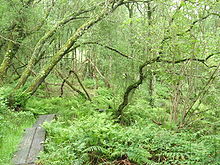|
Wet woodlandA wet woodland is a type of plant community. It is a biodiversity habitat in the United Kingdom as part of the British National Vegetation Classification system. Wet woodlands occurs on poorly drained or seasonally wet soils. They may occur in river valleys, the surroundings of mires and raised bog, the transition zones between open water and drier ground, and beside small winding streams. British National Vegetation ClassificationWithin the British National Vegetation Classification, seven types of wet woodland are recognised as part of the Woodland and scrub communities in the British National Vegetation Classification system:
EcologyIn the UK, alder, birches and willows are the characteristic trees found in this type of habitat, as they are able to extract oxygen from the water saturated habitat. The UK contains between 50–70,000 hectares (120–172,970 acres) of wet woodlands. Wet woodland supports many types of species. E.g. the humidity favours bryophytes (mosses). The shrub and tree community supports many invertebrates: the beetles Melanopion minimum and Rhynchaenus testaceus, the craneflies Lipsothrix errans, Lipsothrix nervosa, and mammals such as Eurasian otters. In the UK Woodland Maintenance and Restoration grants are available to protect this type of Woodland under Natural England's Environmental Stewardship Scheme. Condition assessment and ideal management
The term 'recent' in this context means less than five years. Example Wet Woodland sites
References |
